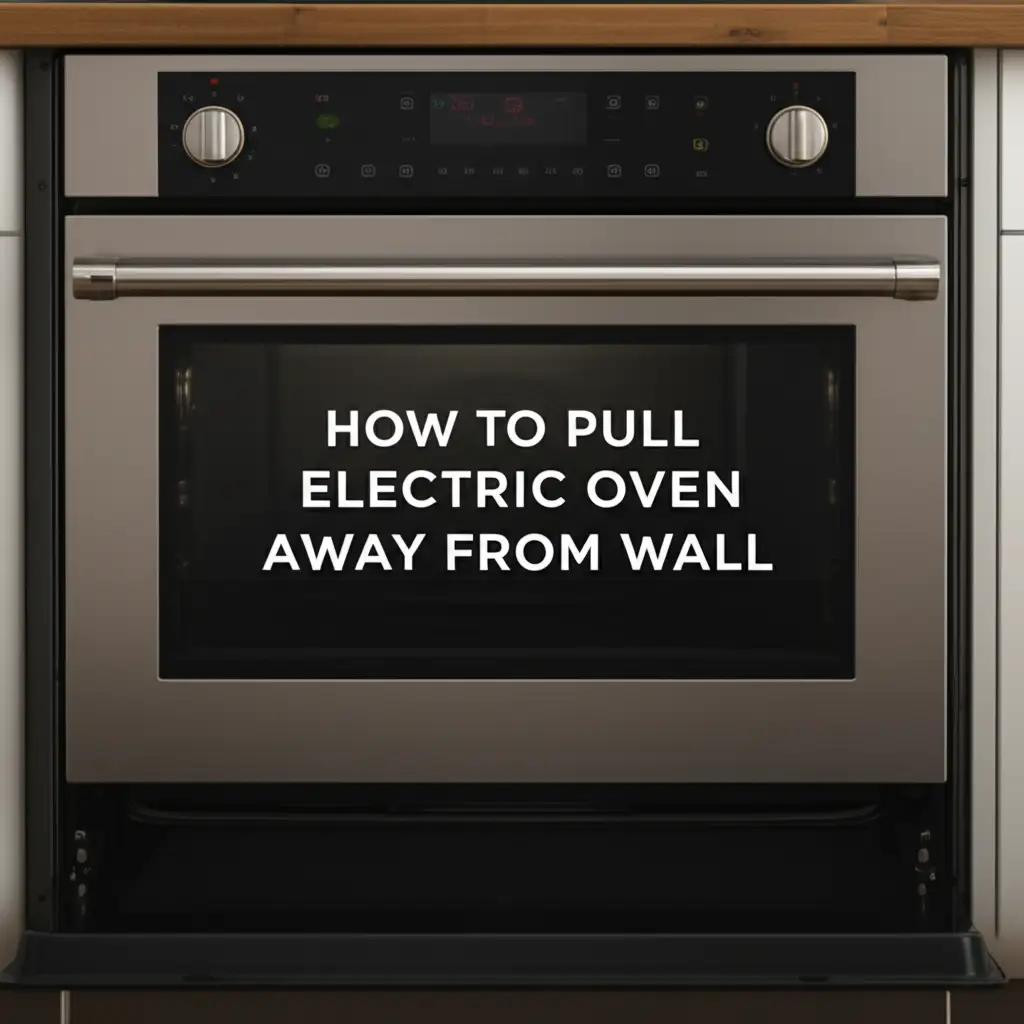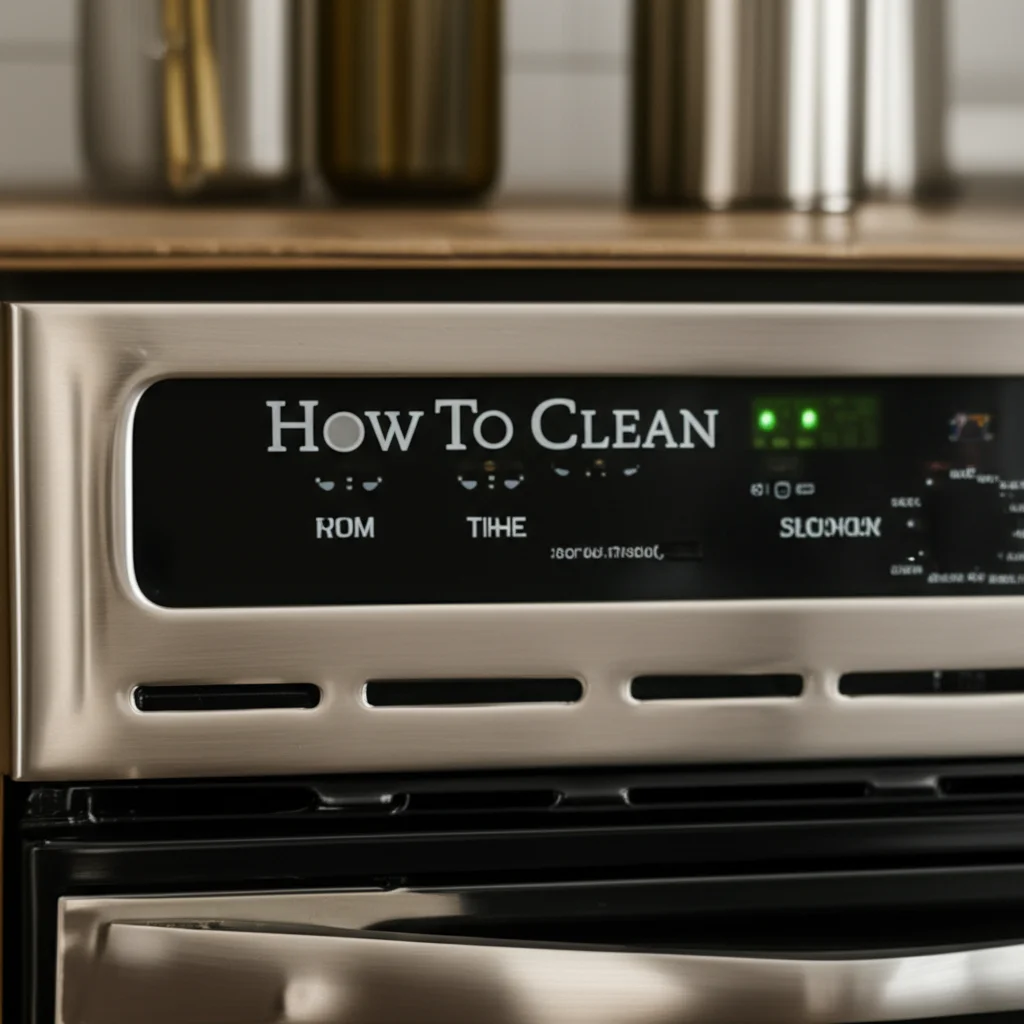· Todd Martin · Home Maintenance · 15 min read
How To Pull Electric Oven Away From Wall

Safely Pull Electric Oven Away From Wall
Have you ever wondered what mysteries lie behind your kitchen oven? That forgotten space often collects dust, crumbs, and even lost utensils. Learning how to pull your electric oven away from the wall is a vital skill for any homeowner. This task is essential for deep cleaning, troubleshooting, or performing necessary repairs. I know it seems daunting at first, but with the right guidance, it is a straightforward process. This article will walk you through every step, ensuring you complete the job safely and efficiently. We will cover preparation, tools, disconnection, movement, and even what to do once the oven is out.
Takeaway:
- Always prioritize safety by disconnecting power first.
- Gather all necessary tools before starting.
- Use proper lifting and moving techniques to avoid injury and damage.
- Clean thoroughly behind the oven when it is accessible.
- Ensure the oven is properly reconnected and tested before use.
To safely pull an electric oven away from the wall, first ensure the power is completely off at the breaker. Then, carefully grasp the oven’s sides or handle and slowly pull it straight out. This allows access for cleaning, maintenance, or repair.
Why You Need to Pull Your Electric Oven Away From the Wall
Pulling your electric oven away from the wall is not just for major repairs. Many reasons exist for needing access to the area behind your appliance. Regular maintenance often requires this step. You might find hidden issues or simply improve your kitchen’s hygiene.
One primary reason is deep cleaning. Crumbs, grease, and dust can accumulate behind the oven. This buildup is not only unsightly but can also attract pests. It can even become a fire hazard over time. A thorough cleaning helps maintain a healthy kitchen environment.
Another common reason is appliance maintenance or repair. Your oven’s electrical cord and outlet are usually located behind the unit. If you need to check connections or replace a faulty part, the oven must move. Sometimes, a part needs access from the rear. This access is impossible without pulling the oven out. Knowing how to clean your electric oven thoroughly extends its life and keeps it working well.
You might also need to access plumbing connections if you have a gas-electric range, although this article focuses on electric ovens. Or, perhaps, you are simply rearranging your kitchen. Moving large appliances is part of a kitchen renovation. In any case, knowing how to safely maneuver your oven is a valuable skill. It saves you money on professional services for simple tasks.
Safety First: Essential Preparations Before Moving Your Electric Oven
Safety is paramount when working with any electrical appliance. Before you attempt to pull your electric oven away from the wall, you must take essential safety precautions. Ignoring these steps can lead to electrical shock, injury, or damage to your home and appliance. I always double-check these steps to ensure peace of mind.
The very first step is to disconnect the power supply. Locate your home’s main electrical panel, also known as the breaker box. Find the circuit breaker labeled for your kitchen or specifically for your oven. Electric ovens typically require a dedicated 240-volt circuit. This breaker is usually larger than standard 120-volt breakers. Flip the breaker switch to the “OFF” position.
Do not rely solely on turning the oven’s controls off. An oven can still have a live power connection even when it seems off. Turning off the breaker ensures no electricity flows to the oven. This prevents accidental shocks. It is a crucial step that protects you.
Next, ensure the oven has cooled down completely if it was recently used. Hot surfaces can cause burns. Give it ample time to cool, perhaps an hour or more, depending on its recent use. Also, clear the immediate area around the oven. Remove any kitchen mats, rugs, or small appliances that could obstruct your path. Ensure there is enough clear space for the oven to move freely. This prevents tripping hazards or damage to other items.
Finally, consider the weight of your oven. Electric ovens are heavy appliances. If you are not confident in your ability to move it alone, ask for help. A second person can make the task much safer and easier. They can help guide the oven or provide support.
Gathering Your Tools: What You Need for the Job
Before you start pulling your electric oven away from the wall, gathering the right tools makes the job much smoother and safer. Having everything ready beforehand prevents interruptions and frustration. Most of these items are common household tools. I always lay out my tools on a clean cloth nearby.
Here is a list of the tools and materials you will likely need:
- Work Gloves: Heavy-duty work gloves protect your hands from sharp edges, dirt, and grime. Ovens often have unfinished metal edges underneath.
- Flashlight or Headlamp: The area behind the oven can be dark. A flashlight helps you see the outlet and any debris clearly. A headlamp keeps your hands free.
- Screwdriver Set (Phillips and Flathead): You might need screwdrivers to remove any anti-tip brackets. These brackets secure the oven to the floor or wall.
- Pry Bar or Flat Tool (optional): Sometimes, an oven can be stuck to the floor, especially on linoleum or vinyl. A thin pry bar can help gently break the seal. Use caution to avoid scratching your floor.
- Old Towels or Cardboard: These items can protect your floor from scratches as you slide the oven out. You can place them under the oven’s legs or wheels.
- Dustpan and Brush or Vacuum Cleaner: Once the oven is out, you will want to clean the accumulated dirt. A vacuum with a hose attachment is ideal for tight spaces.
- All-purpose Cleaner and Rags: For cleaning the floor and walls behind the oven. You might also want to clean the oven’s exterior or rear.
- Safety Glasses: Protect your eyes from dust or debris that might fly up during cleaning or movement.
Having these tools at your fingertips will streamline the process. They ensure you can perform each step efficiently and with minimal fuss. A well-prepared workspace is a safe workspace.
Step-by-Step Guide: How to Safely Disconnect Your Electric Oven
Once you have prepared your work area and gathered your tools, the next crucial step is safely disconnecting your electric oven. This process involves more than just pulling it out. You need to handle its electrical connection properly. I take my time with this part, as electrical safety is very important.
First, confirm that the power to the oven is off at the breaker box. I mentioned this in the safety section, but it bears repeating. This is the single most important safety step. Test an outlet in the kitchen or turn on a light to confirm other circuits are still live, but the oven is not.
Most electric ovens connect to a wall outlet. This outlet is usually a large, three-pronged or four-pronged receptacle. It looks different from standard household outlets. As you begin to pull the oven away from the wall, you will reveal this outlet. Pull the oven out just enough to gain access to the power cord.
Reach behind the oven and firmly grasp the oven’s power cord plug. Pull the plug straight out from the wall outlet. Avoid pulling on the cord itself, as this can damage the wires or the plug. If the plug is stiff, a gentle wiggle can help, but do not force it. Ensure the plug is completely disengaged from the outlet.
Some older or commercial electric ovens might be hardwired directly into your home’s electrical system. This means there is no plug to disconnect. If your oven is hardwired, you should not attempt to disconnect it yourself unless you are a qualified electrician. Contact a professional to handle this. For most home users, it will be a simple plug-and-play setup. If you’re unsure whether you have an electric oven, it’s good to know the common signs; learn how to know if you have an electric oven.
Additionally, some ovens have an anti-tip bracket. This metal bracket attaches to the floor or wall behind the oven. It prevents the oven from tipping forward when heavy pots are on the open door. You might need to gently lift the oven slightly or use a screwdriver to disengage it from this bracket. Once the power is disconnected and any anti-tip brackets are clear, your oven is ready for full movement.
The Art of Movement: Pulling Your Oven Away from the Wall
With the power disconnected and any anti-tip brackets disengaged, you are ready to move your electric oven. This step requires proper technique to avoid personal injury or damage to your floor. Remember, electric ovens are very heavy. I find that a steady, controlled approach works best.
Most freestanding electric ovens have small wheels or rollers on their rear legs. This design makes them easier to move. Some slide-in models may not have these rollers. Begin by firmly grasping the sides of the oven. Avoid pulling on the oven door handle or controls, as these parts are not designed for moving the entire unit. Get a good grip, ideally near the bottom or mid-point of the side panels.
Now, gently rock the oven slightly forward and back to loosen it. Then, pull it slowly and steadily straight away from the wall. The goal is to move it in a straight line. Do not twist or angle the oven too much. Twisting can damage your floor or the oven’s legs. If your oven feels stuck, do not yank it. You might need to use a pry bar carefully under the front legs to break any suction with the floor, especially on vinyl or linoleum. Always place a towel or cardboard under the pry bar to protect your floor.
As the oven moves, watch for the power cord. Ensure it does not snag or get crushed under the oven’s wheels or legs. Guide the cord as the oven comes out. Pull the oven out just far enough to comfortably access the area behind it. There is no need to pull it entirely into the middle of the kitchen. A foot or two of clearance is usually sufficient.
If you are working alone and the oven is very heavy, you can try pulling one side out a few inches, then the other side, alternating. This “walking” method can help. However, for heavier units, having a second person is strongly recommended. They can help support the weight and guide the oven. Some people wonder about the heat behind the appliance; generally, the back of an electric oven does get hot, so be mindful of this during movement.
Cleaning and Maintenance: What to Do Once the Oven is Out
Once you successfully pull your electric oven away from the wall, a world of forgotten dirt and grime will likely greet you. This is your prime opportunity for a deep clean and quick inspection. Do not miss this chance. I always feel a sense of accomplishment once I see how clean the area becomes.
Start by grabbing your vacuum cleaner with a hose attachment. This is perfect for reaching into tight corners and sucking up all the loose dust, crumbs, and debris. Pay special attention to the floor directly behind where the oven sits. You might be surprised at what you find! I’ve found lost spices, pet toys, and even small utensils back there. Use the brush attachment for stubborn bits.
After vacuuming, use an all-purpose cleaner and a damp rag to wipe down the exposed floor and the section of the wall behind the oven. Grease and splatters can accumulate here. A degreaser might be necessary for really tough spots. Also, take a moment to wipe down the back and sides of the oven itself. Dust and grime can cling to these surfaces, especially on cooling vents. Keeping the vents clear can improve oven efficiency.
While the oven is out, quickly inspect its power cord for any signs of fraying, cracking, or damage. Check the plug as well. If you notice any damage, consider replacing the cord before pushing the oven back. This is also a good time to check the floor for any damage or moisture. Address any issues you find before they become bigger problems.
Consider this an annual or semi-annual task. Regular cleaning behind your oven prevents excessive buildup. It also helps maintain good air quality in your kitchen. A clean environment contributes to a healthier home.
Reconnecting and Testing: Putting Your Electric Oven Back
After you have completed your cleaning and inspection, it is time to slide your electric oven back into place and reconnect it. This final stage requires careful attention to detail to ensure the oven functions safely. I always take a deep breath here, knowing I am almost done.
First, make sure the area where the oven will sit is completely clear and dry. Slowly and carefully, push the oven back towards the wall. Guide it in a straight line, just as you pulled it out. Be mindful of the power cord. Ensure it does not get pinched or caught underneath the oven as you slide it back. The cord should naturally feed into the space behind the oven.
As the oven gets close to the wall, visually align its legs with any floor indentations. If your oven has an anti-tip bracket, gently lift the front of the oven slightly. Ensure its rear leg or bracket slides correctly back into the anti-tip mechanism. This bracket is crucial for safety, preventing the oven from tipping over. Make sure it is securely engaged.
Once the oven is fully in position, reach behind it and firmly plug the power cord back into the wall outlet. Ensure the plug is seated tightly and completely. There should be no gap. Then, return to your main electrical panel. Flip the circuit breaker for your oven back to the “ON” position.
Now, it is time to test the oven. Turn on the oven’s lights and try setting it to bake or broil. Listen for the elements heating up. If the oven powers on and the elements begin to heat, you have successfully reconnected it. If the oven does not turn on, recheck the breaker and the plug connection. Sometimes, an oven might not turn on immediately after being moved. If you find your electric oven is not turning on, double-check all connections. You can also review if you can use an electric oven straight away after a long period of disuse.
Congratulations! You have successfully pulled your electric oven away from the wall, cleaned it, and put it back safely. This task helps maintain your appliance and keeps your kitchen clean.
Frequently Asked Questions
How much space do I need behind an electric oven?
Most electric ovens require a minimum of 1 to 2 inches of clearance from the back wall for ventilation. This space allows for proper airflow and prevents overheating. It also accommodates the power cord and plug. Always check your oven’s specific manual for exact clearance requirements.
Can I pull an electric oven out by myself?
You can pull an electric oven out by yourself, but it is often safer and easier with two people. Electric ovens are very heavy. Moving them alone risks injury to yourself or damage to your floor or the appliance. Assess your strength and comfort level before attempting it solo.
What if my electric oven is hardwired?
If your electric oven is hardwired directly into your home’s electrical system, it does not have a plug. You should not attempt to disconnect it yourself. Hardwired appliances require a qualified electrician for safe disconnection and reconnection. Contact a professional for this type of oven.
How often should I pull my oven away from the wall for cleaning?
For optimal kitchen hygiene and appliance maintenance, consider pulling your oven away from the wall for cleaning at least once a year. If you cook frequently or have pets, you might want to do it twice a year. This prevents excessive buildup of dust and grime.
What are common hazards when moving an oven?
Common hazards include electrical shock from not disconnecting power, personal injury from lifting a heavy appliance, and damage to floors from dragging the oven. There is also a risk of damaging the oven’s power cord. Always follow safety precautions and use proper moving techniques to mitigate these risks.
Can I use the oven immediately after moving it back?
Yes, after securely plugging the oven back in and restoring power at the breaker, you can generally use your electric oven immediately. It is a good practice to turn it on to a low temperature setting first. This confirms it is heating correctly and safely before full use.
Conclusion
Successfully pulling your electric oven away from the wall is a practical skill that empowers you to maintain a cleaner and safer kitchen. We have walked through every step, from the vital safety preparations to the careful movement and thorough cleaning. Remember, disconnecting the power at the breaker is always the first and most important step. Gathering your tools and understanding the proper techniques for moving and cleaning will make the task straightforward.
By following these guidelines, you can confidently access that often-neglected space behind your appliance. This helps in deep cleaning, troubleshooting, or simply ensuring better airflow for your electric oven. Regular maintenance, including pulling your electric oven away from the wall, extends its lifespan and contributes to a healthier home environment. Now, you have the knowledge to tackle this task with confidence. Go ahead, give your kitchen the deep clean it deserves!





